Rating of the best antibiotics for the treatment of otitis media for 2025
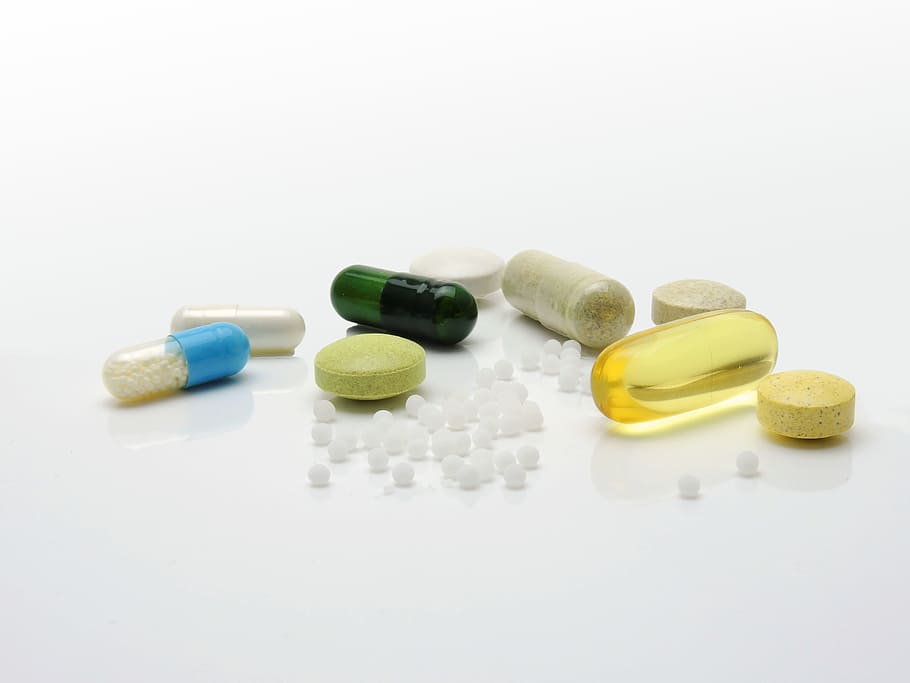
Proper treatment of pain, inflammation of the hearing organs - only under the guidance of specialists. Studying the rating of the best antibiotics for the treatment of otitis media for 2025, you can choose the right drug, using the advice of doctors.
Content [Hide]
Anatomical structure
The ear is a paired hearing organ in the temporal part of the head. The main functions are capturing, transmitting sound vibrations, maintaining balance.
There are three parts of the ear: outer, middle, inner.
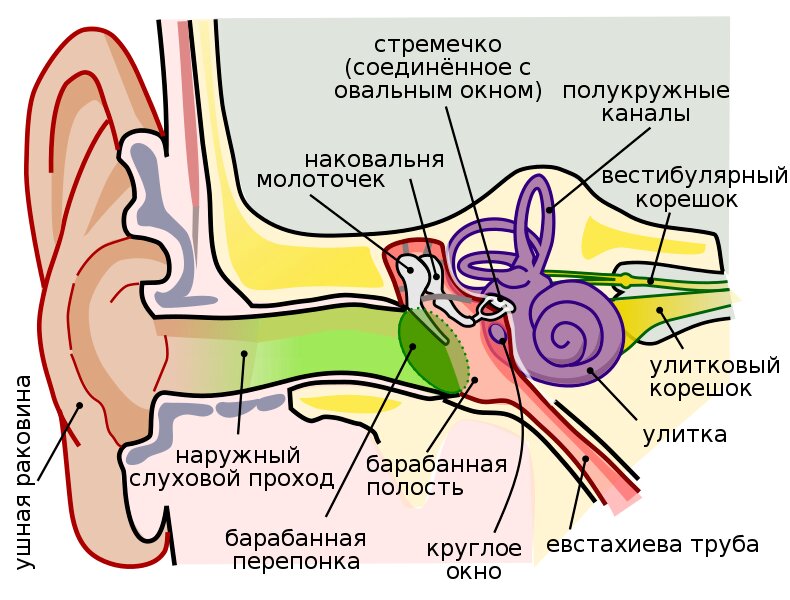
outer ear
Represented by the auricle (cartilaginous tissue), external auditory meatus (24-30 mm). From the inside - the skin with glands. Ear wax is secreted by the sulfur glands, protects against infections, ingress of small insects (specific smell).
Function - collection of sound information, transmission to the next middle department.
Middle ear
Sound waves reach the eardrum (membrane) and cause it to vibrate. Behind the membrane of the temporal bone there is a cavity (volume 1 cm3), three auditory ossicles - an anvil, malleus, stirrup. The membrane is connected by ligaments to the handle of the malleus, the head of the malleus is connected to the anvil, the anvil is connected to the stirrup, the base of the stirrup is the inner part.
Function - transmission, amplification of sounds to the inner ear.
Eustachian (auditory) tube connects the middle part with the nasopharynx, equalizes pressure.
The feeling of congestion in the ears is a change in external pressure. To equalize pressure, reduce congestion, you can eat cookies, drink water (make swallowing movements), blow into a nose pinched with your fingers, yawn several times.
Inner ear (labyrinth)
Components: vestibule, cochlea, semicircular canals. The cochlea and the membranous canal are filled with lymphatic fluid.The cavity of the membranous canal consists of cells with hairs that pick up sound vibrations of a certain frequency. The upper frequencies are captured by the hairs of the lower part of the cochlea, the low frequencies are captured by the upper part. The hairs are connected to the fibers of the auditory nerve, through which electrochemical signals enter the brain, where they are received and a sound image is formed.
The ability to perceive different frequencies is lost over time, due to the death of cells in a certain part of the cochlea.
Otitis
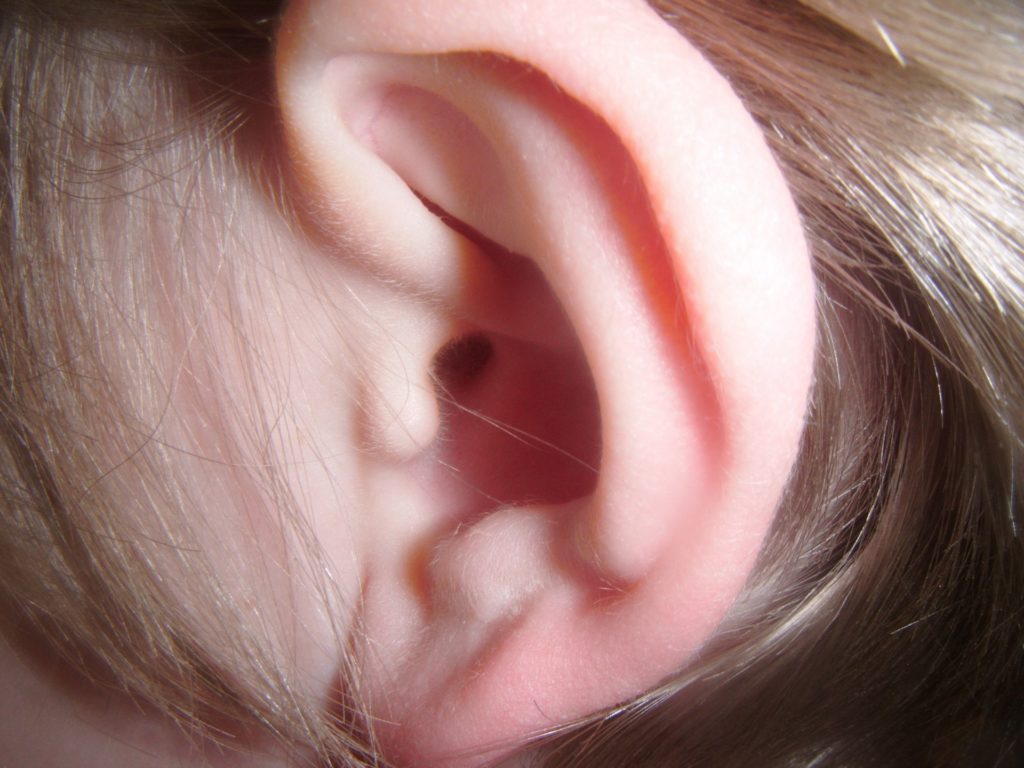
Otitis media is an inflammatory disease of the ear. It happens one-, two-sided (simultaneous damage to two organs, typical for young children).
General symptoms:
- acute pain in the ear (may increase in the evening, at night);
- loss of appetite, general weakness;
- increase in body temperature to 38⁰ - 40⁰;
- hearing loss;
- discharge (purulent);
- tilting, shaking the head (small children).
There are three main types of otitis: external (external), middle, internal.
Otitis externa
The main symptoms include swelling of the auricle, ear canal, increased pain when you open your mouth, the appearance of boils (metabolic disorders).
The reason is improper hygiene, injuries, the presence of sulfur plugs, a violation of the metabolic processes of the body.
There are two types:
- limited - inflammation in a small area, boil;
- diffuse - redness of the entire auricle, ear canal.
Three causes of diffuse otitis externa are fungal (otomycosis), allergic (dry, wet eczema), bacterial (infection through microcracks, with injuries).

Athletes have a "swimmers' disease" with prolonged contact with water, a constant change in pressure (diving).It is recommended to use a swimming cap, special ear plugs (plugs), which must be constantly treated with antiseptics.
Otitis media
It spreads to the ear with the tympanic membrane, a cavity with three auditory ossicles, and the Eustachian tube. Children often get sick because of the peculiarities of the anatomical structure of the Eustachian (auditory) tube - in children it is already in diameter, it is located horizontally (in adults at an angle).
There are two types:
- Acute otitis media (AOM) - a sharp ear pain (increased at night), fever, loss of appetite.
- Exudative otitis media (ESO) - accumulation of fluid in the cavity.
Complications may occur: perforation (rupture) of the eardrum, purulent discharge, hearing loss.
Otitis media (labyrinthitis)
Inflammation of the inner ear occurs as a complication after acute, chronic otitis media, infectious disease (tuberculosis), trauma.
Symptoms are nausea, vomiting, tinnitus, dizziness, loss of balance. Confirmation of the diagnosis by a doctor - after passing a clinical blood test, x-ray of the temporal sinuses of the skull bones. Treatment depends on the severity of the disease, different types of antibiotics, bed rest, and surgery are used.
Treatment
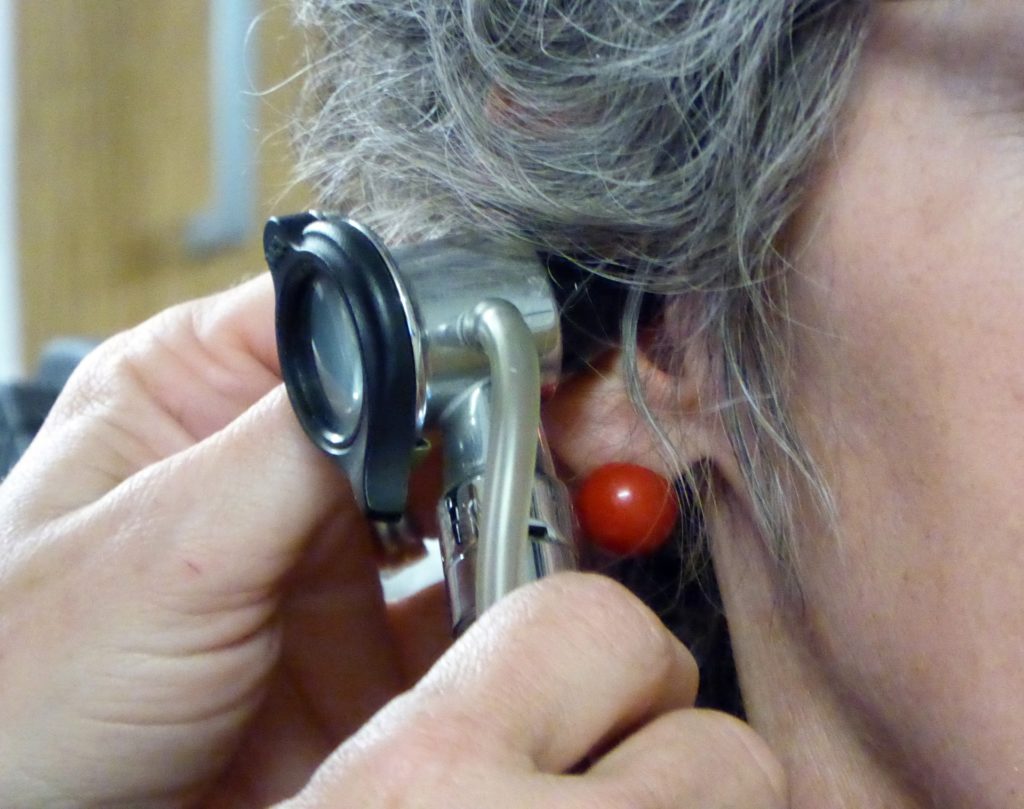
Incorrect, untimely treatment of otitis media can lead to deafness, labyrinthitis, and intracranial changes.
Causes of otitis:
- infectious diseases (rhinitis, sinusitis);
- allergy;
- the presence of chronic diseases (diabetes);
- decreased immunity;
- bathing in pools, reservoirs;
- injuries (improper cleaning, sharp objects).
Be sure to contact your family doctor, doctor - otolaryngologist.
Otitis externa - reduction of swelling of the external auditory canal, removal of inflammation.
Otitis media - prescribe painkillers, antipyretics, anti-inflammatory, antibacterial drugs.
Diseases of the inner ear - damage to the auditory, vestibular apparatus. Symptoms - hearing impairment, noise, dizziness, nausea, loss of body balance, weakness.
Sulfur plug occurs with excessive formation of sulfur secretion, improper hygiene (irregular cleaning, use of ear sticks). When water gets in, sulfur swells, can flow into the deep sections of the ear canal - leading to hearing loss, tinnitus. Mandatory consultation, cleaning with a specialist otolaryngologist.
Bathing in prohibited water bodies can lead to otitis if local immunity is reduced.
There are two types of the course of the disease (depending on the duration):
- Acute - a sharp increase in symptoms (15-28 days).
- Chronic - occurs due to improper prescription of drugs, untimely treatment (26-30 days, repetition after 3-4 months).
Antibiotics
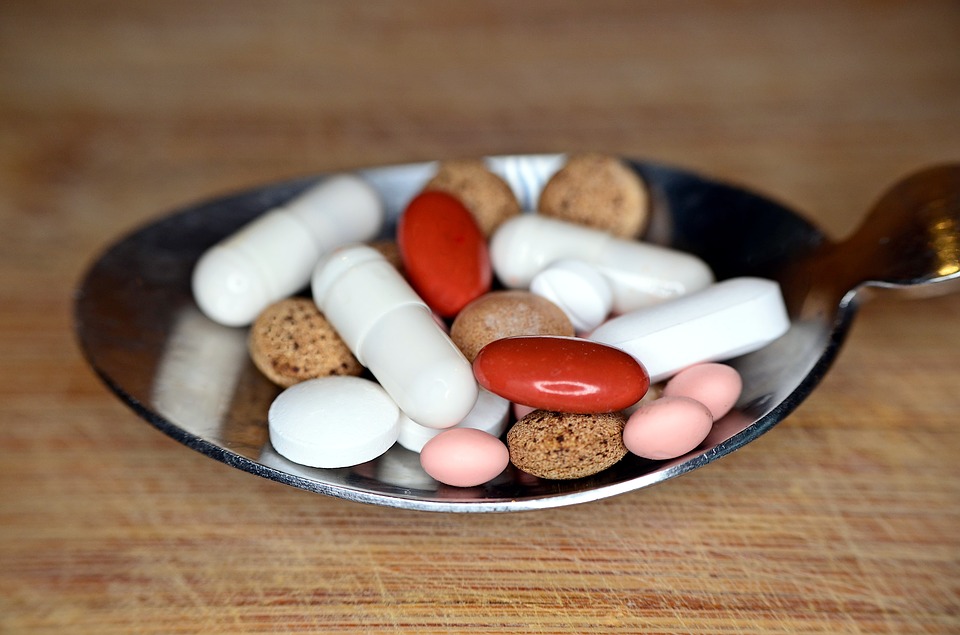
The word "antibiotics" means anti - against, bio - life. They are used to treat bacterial diseases, do not affect viral cells.
The first antibiotic "penicillin" was isolated by Alexander Fleming (1928), but was unstable, destroyed after a short time. The scientists Flory and Chain (1938) increased the resistance of penicillin by creating a salt of penicillin acid. Mass production of penicillin began in 1943. Scientists Fleming, Flory, Chain received the Nobel Prize for the discovery of the first antimicrobial compound (1945).
There are two groups of antibiotics (the effect on the bacterial cell):
- Bactericidal - bacteria die, are excreted from the body.
- Bacteriostatic - bacteria lose their ability to multiply, increase their number, but remain alive.
According to the chemical structure, the following groups are distinguished:
- beta-lactam - penicillins, cephalosporins, carbapenems;
- macrolides;
- tetracyclines;
- chloramphenicol;
- lincosamides;
- aminoglycosides;
- fluoroquinolones - ofloxacin, norfloxacin.
Penicillins
The active ingredients are penicillin, amoxicillin, amoxicillin + clavulanic acid. Works on most bacteria.
Often cause allergic reactions (skin itching, urticaria), reduce the effect of birth control pills. Approved for use by young children, pregnant women. Clavulanic acid is added to protect against resistant bacteria.
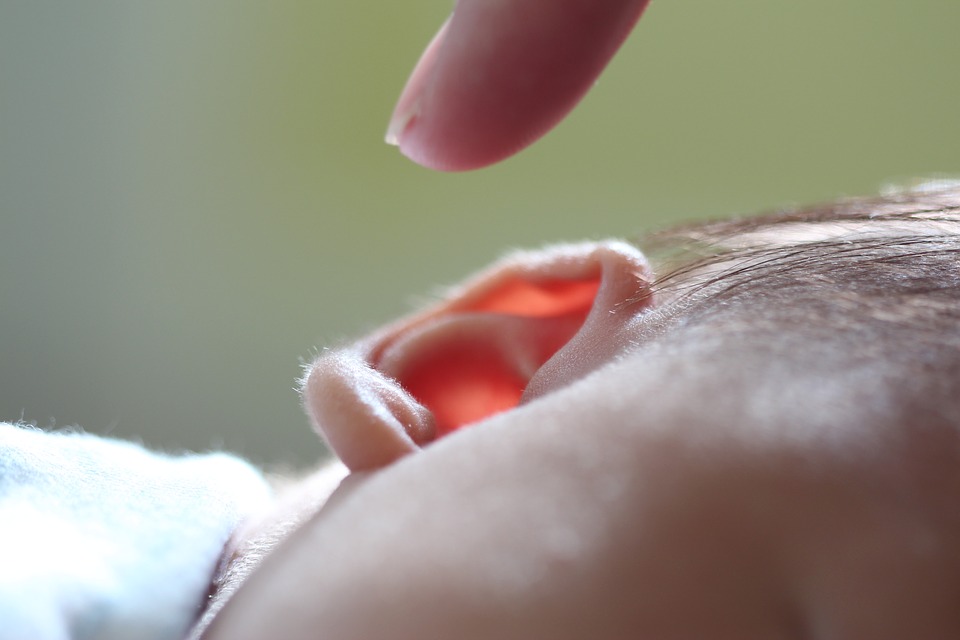
Cephalosporins
There are drugs for intravenous, intramuscular use, tablet types (cefixime). It is used for severe forms of infectious diseases in children from birth, pregnant, lactating women (dose, duration - individually).
Allergic reactions are possible. Release form - tablets, powder (preparation of suspensions), capsules.
Fluoroquinolones
Drugs - ofloxacin, moxifloxacin, ciprofloxacin, levofloxacin. They are used for severe forms of diseases, ineffectiveness of other types of antibiotics.
They can cause disturbances in the formation of cartilage tissue, muscle and joint pain, drowsiness, and sensitivity to UV rays. Contraindicated in children under 18 years of age, pregnancy, lactation.
Reception features - avoid direct sunlight (reception period, after a course of 3-4 days), do not combine with certain drugs (zinc, iron, from high acidity of gastric juice), drink medicines with plenty of water (250-300 ml).
Macrolides

Drugs - azithromycin, erythromycin, roxithromycin, midecamycin, clarithromycin. They have a bacteriostatic effect - they disrupt the ability of bacteria to multiply (improvement occurs after a few days).
Release form - suspensions, capsules, tablets. It is important to comply with the conditions of admission - drink on an empty stomach, do not use other medicines. Re-use - only after 3-5 months (resistance quickly appears).
The novelty of 2019 is the antibiotic lefamulin (a class of pleuromutilins with a new mechanism of action). Developed by scientists to treat severe forms of pneumonia. Lefamulin has been approved by the US government for use since 2019.
Buying Tips
The main rule is not to purchase any medications without consulting specialists (family doctor, otolaryngologist). Incorrect selection of treatment leads to a chronic long-term course of the disease, severe complications (hearing loss, damage to the meninges - meningitis), the emergence of resistance (resistance) of bacteria to antimicrobial substances.
The doctor selects the active substance, concentration, form of release, duration of the course, depending on the following factors:
- the severity of the disease;
- age;
- the presence of chronic diseases, allergic reactions to constituent components;
- the use of other drugs (interaction is taken into account);
- use of antimicrobials in the past;
- analysis is carried out for the sensitivity of microflora to different types of antimicrobial agents (smear, puncture of purulent contents);
- without sensitivity analysis - a broad-spectrum drug;
- the effectiveness of the drug - within 3 days (if the condition worsens, an additional consultation of the doctor is required, the replacement of the antimicrobial drug).
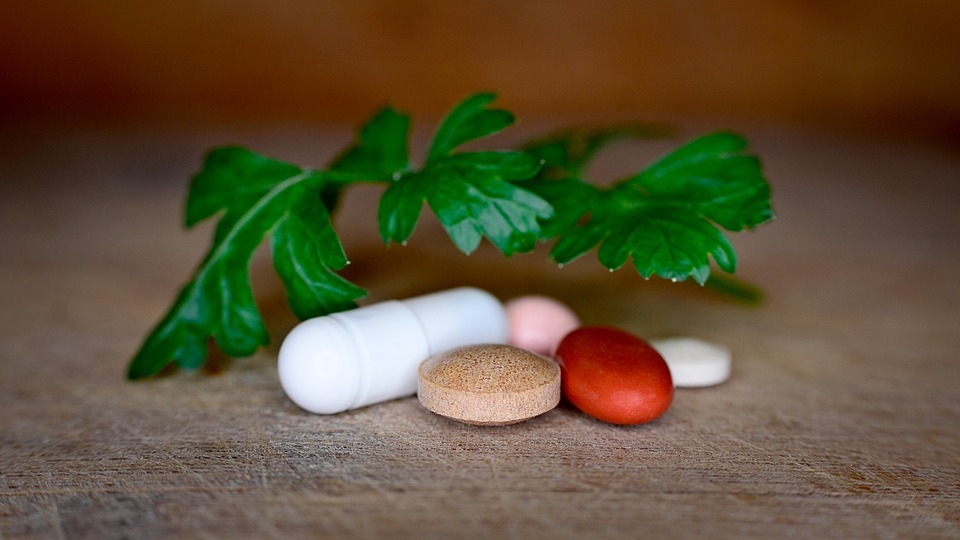
Additional tips for choosing medications:
- Buy prescription drugs.
- Know the name of the drugs, their active substance.
- Choose the appropriate form of release (drops, capsules, tablets, syrup).
- Read the instructions for use, side effects, contraindications.
- Do not change the dose, quantity, time of administration, duration of treatment on your own.
- Familiarize yourself with quality certificates, terms of use, storage conditions.
- Find out the prices for the prescribed medicine from nearby pharmacies, online resources.
Prevention of diseases of the hearing organs

You can reduce the incidence of various types of otitis by following simple rules, expert advice:
- proper hygiene - cleaning the ears without cotton buds (the formation of sulfur plugs is possible), separate cleaning of each nostril;
- bathing in clean water bodies (pool, river), drying the external auditory canal with a towel;
- increased immunity (eliminate addictions - smoking, a sufficient amount of vitamins, minerals in a varied menu, hardening, walking in the fresh air);
- vaccinate (against pneumococcal, hemophilic infection, seasonal influenza);
- proper treatment of respiratory diseases under the supervision of specialists (rhinitis, sinusitis, sinusitis);
- selection of high-quality headphones (listening to music, computer games);
- listen to music using in-ear headphones for no more than 2-3 hours per day (1 hour without a break);
- do not increase the sound volume more than 60%;
- remove excess sulfur from an ENT doctor;
- infants - do not give pacifiers, bottles of food, water for a long time.
Rating of the best antibiotics for the treatment of otitis media for 2025
All antibacterial drugs are prescription (sold by pharmacies by prescription), are prescribed individually by a family therapist, an otolaryngologist.
For outdoor use
Release form - drops, be sure to heat to body temperature before instillation - hold the bottle in a clenched palm for 1-2 minutes.
Ciprofloxacin-solofarm eye and ear drops 0.3% vial-dropper 5ml №1
votes 0
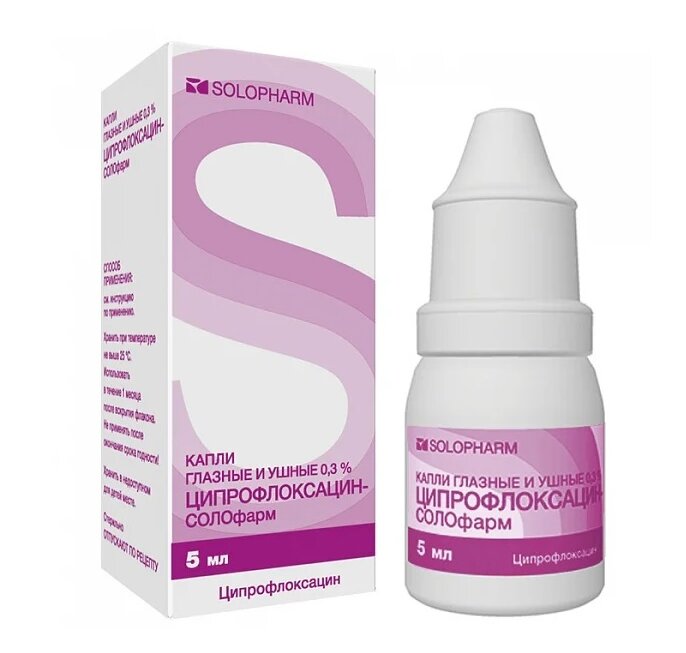
The manufacturer is the pharmaceutical company Grotex LLC (Russia).
The active substance is ciprofloxacin (fluoroquinolones for topical use). Assign for the treatment of eye, ear diseases (otitis externa, postoperative complications).
Application: clean the external passage, drip 3-4 drops 2-4 times a day, lie on your side for 5-10 minutes. The duration of treatment is 5-10 days.
Shelf life - 3 years (after opening - 4 weeks), in a dry, dark place at temperatures up to 25⁰С.
- application in otolaryngology, ophthalmology;
- price.
- children's age up to 1 year;
- allergic reactions;
- viral keratitis.
Dancil drops eye/ear 0.3% 5ml №1
votes 0
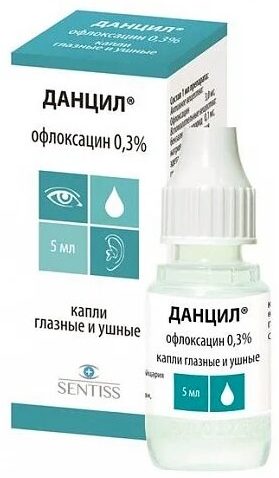
The manufacturer is the Russian company Sentiss.
The active substance is ofloxacin (local) Antimicrobial agent, fluoroquinolone. Assign adults, children after 1 year with ear infections (external, purulent otitis media), infections in ophthalmology.
Application: adults, children after 12 years - 10 drops 2 times a day (course - 10 days). Children under 12 years old - appointment of an otolaryngologist, outpatient observation.
The patient should lie on his side, after instillation - 5 minutes.
- treatment of eye and ear diseases;
- a wide range of activities;
- price.
- careful use when driving;
- period of pregnancy, lactation;
- children's age up to 1 year;
- long-term use - control of blood glucose levels, organ functions.
Otofa ear drops. 10ml №1
votes 0
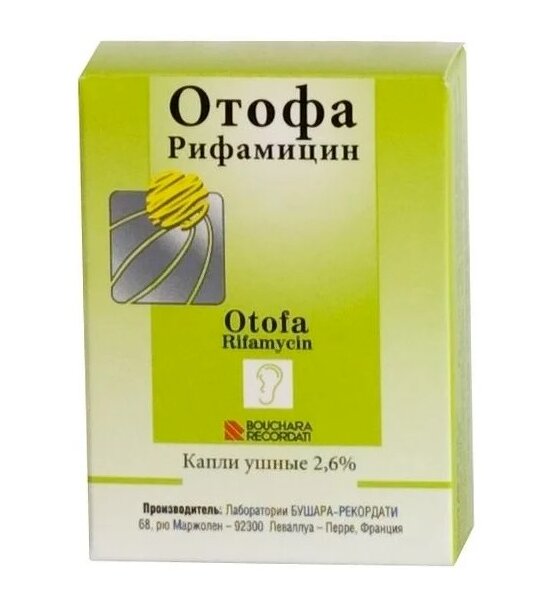
Manufactured by a pharmaceutical company - Pharmaster (France). The active substance is rifamycin, a local antibiotic. Assign for chronic, acute otitis, perforation of the eardrum, operations on the middle ear. Adults, children over 12 years old.
Apply 5 drops (adults), 3 drops (children) - 3 times a day. It is possible to fill the drug for 2-3 minutes 2 times a day. Course - 7 days (5-10)
Storage conditions - temperature up to 25⁰С. Shelf life - 3 years.
- a wide range of activities;
- use in violation of the eardrum;
- adults, children over 12 years old;
- does not affect driving ability;
- price.
- can leave stains on clothes;
- skin allergic reactions (itching, urticaria);
- not for lactating, pregnant women.
Tsipromed ear drops. 0.3% 10ml
votes 0
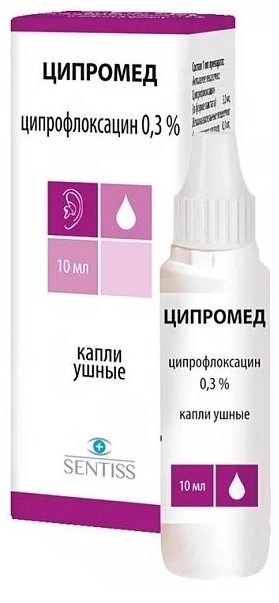
The manufacturer is SENTISS PHARMA, Pvt. Ltd. (India).
The active substance is ciprofloxacin, a group of fluoroquinolones. Has a wide spectrum of activity.
It is prescribed for adults, children after 15 years. It is used in the treatment of: otitis externa, otitis media, internal otitis, inflammation of the Eustachian tube, ear tissue damage (before, after surgery).
Application: rinse, dry the external auditory canal, drip 5 warm drops (3 times a day), pull the lobe down and back. Lie on your side (sit with your head thrown back) for 2 minutes, put a cotton turunda.
The course of treatment - according to the recommendations of the attending physician, 48 hours after the disappearance of symptoms. Store in a dark place, temperature - up to 25⁰С. Shelf life - 2 years. After opening the bottle - 30 days.
- wide functionality;
- convenient bottle;
- price.
- short shelf life after opening the vial;
- it is impossible for pregnant, lactating women;
- children's age up to 15 years;
- allergy to quinolones.
Candibiotic ear drops. 5ml №1
votes 0
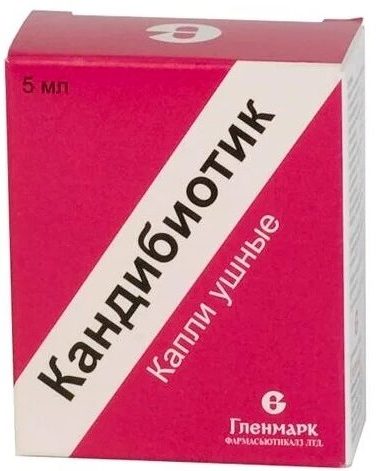
Manufactured by Glenmark (India). Assign for different types, stages of otitis media (exacerbation of chronic, acute external, medium) for adults, children after 6 years. Combined drug - consists of four components:
- Clotrimazole is an antifungal agent.
- Chloramphenicol is a broad-spectrum bacteriostatic antibiotic.
- Beclomethasone - against allergies, inflammation.
- Lidocaine is a local anesthetic (relieves pain).
Buried in the ear canal 3-4 times a day, 4-5 drops. The course of application is 7-10 days.
Storage conditions - dry, dark place, temperature up to +25⁰С. The term of use is 2 years.
- quickly relieves pain;
- 4 components - action on different causes;
- Ease of use;
- price.
- restriction - children under 6 years old;
- damage to the eardrum;
- allergic reactions.
Oral preparations
They have a wide spectrum of action, they are prescribed for infections of various body systems. They differ in the active substance, concentration, rules of administration, form of release.
Unidox solutab tab. dispersion 100mg #10
votes 0
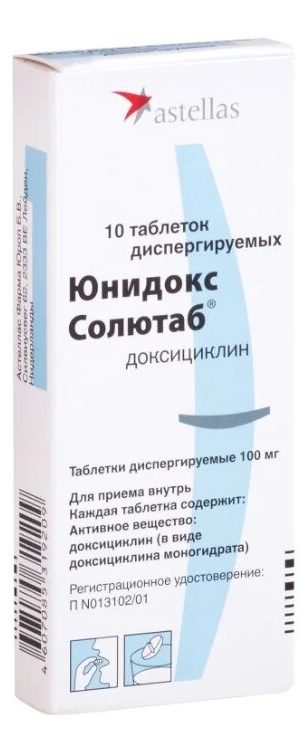
Manufacturer: Astellas / ZiO-Health (Japan / Russia). Form - tablets that dissolve quickly in water (preparation of a suspension). The active substance is doxycycline, bacteriostatic action.
Assign adults, children after 12 years (body weight over 45 kg) 1-2 pcs. for 1 time / day. The concentration in children over 12 years of age (weight - less than 45 kg) is calculated from the ratio of 2.2 mg / kg of body weight 1-2 times a day.
The tablet is dissolved in a small amount of water, swallowed whole, divided into small parts, washed down with liquid.
It is necessary to drink the suspension in the first half of the day in a standing position, sitting (to minimize irritation of the esophagus). If irritation of the esophagus occurs, take with meals.
Storage conditions - dry, dark place, temperature up to 25⁰С.
- convenient reception (suspension);
- there is no binding of application to meals;
- can be consumed with dairy products.
- possible intolerance to the components;
- not during lactation, pregnancy;
- restrictions - children under 12 years old;
- high price.
Amoxiclav tab. p.p.o. 875mg+125mg №14
votes 0
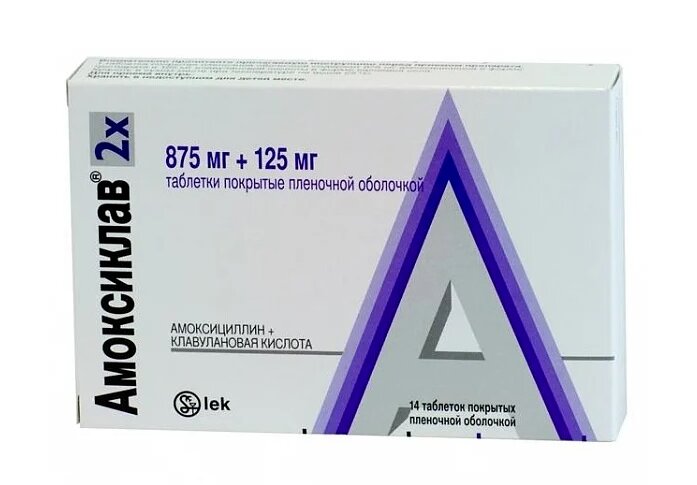
Producer: Lek d.d. (Slovenia, Germany). Octagonal yellow-brown tablets, dispersible (dissolve) in the mouth. The active ingredients are amoxicillin, clavulanic acid.
Take 2 tablets in 2 divided doses at the beginning of a meal (adults, children over 12 years of age). Tablets to swallow, do not chew, can be divided into halves. The duration of the course is an individual appointment.
Shelf life - 2 years at a temperature of + 5⁰ - + 25⁰С. Packing - cardboard box, 7 blisters (2 pcs.).
- acts on many types of microbes;
- clavulanic acid enhances the effect of the drug;
- convenient application schedule.
- additives - aspartame (E951), flavors;
- allergic manifestations (any penicillin-type drugs);
- not for children - up to 12 years;
- pregnant, lactating women - by appointment;
Azithromycin caps. 500mg #3
votes 0

Manufactured by the Russian company "Production of Medicines" (Promed). Gelatin hard capsules with white powder inside.Content - azithromycin (macrolide group), bacteriostatic effect on bacteria.
Assign adults, the elderly, children after 12 years (body weight - more than 45 kg) 1 capsule per day. The drug is not dependent on food.
Shelf life - 3 years, dark, dry, out of the reach of children.
- convenient reception;
- prescribed to older people;
- low cost.
- not for children under 12 years old (weight less than 45 kg);
- severe form of renal, hepatic insufficiency;
- allergy to a group of macrolides;
- lactation period.
Ciprofloxacin tab. p.p.o. 500mg #10
votes 0
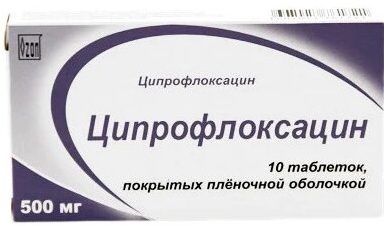
The manufacturer is the Russian pharmaceutical company OZON LLC. White film-coated tablets, cylindrical. The active substance is ciprofloxacin (a group of fluoroquinolones), bactericidal effect.
Application schedule - individual, usually - 1-2 pcs. for 2 times / day. Course duration: 7 days - 3-4 months. The maximum daily dose is 1.5 g.
Cautious use: elderly, the diagnosis is a violation of the kidneys (adjustment of concentration).
Cautious use with preparations of zinc, iron, magnesium - a break of 4-5 hours.
Storage - 3 years at temperatures up to 25⁰С, out of the reach of children. Packing - cardboard box, 1 contour cell plate.
- great functionality;
- patients with reduced immunity;
- convenient to take - any time;
- low price.
- period of pregnancy, feeding;
- children's age up to 18 years;
- allergy to a group of fluoroquinolones.
Amoxicillin caps. 500mg #16
votes 0
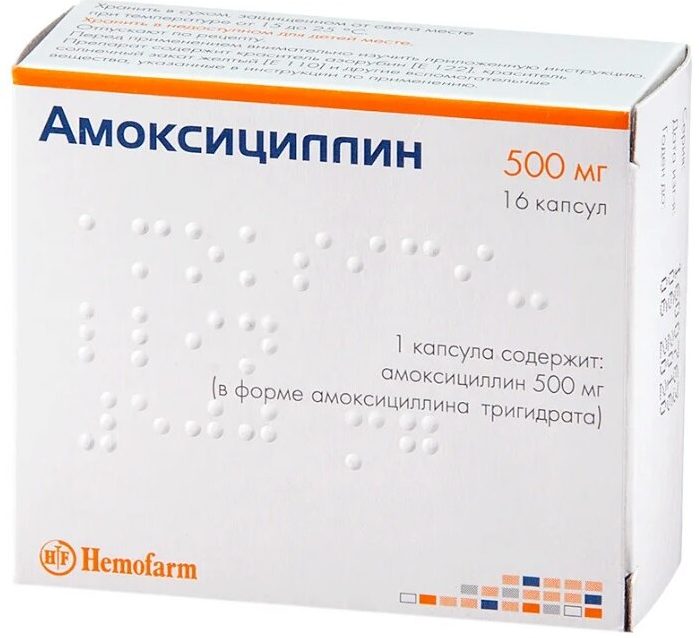
Producer - Hemofarm (Serbia). Gelatin capsules, yellow (body), red (lid). Inside the capsule is a white granular powder.
The active substance is amoxicillin (a group of penicillins of the 3rd generation). Has antibacterial, bactericidal action. Great functionality. Rapidly absorbed, not destroyed by the action of the gastric juice of the stomach.
Individual dosage regimen, duration. Children under 5 years old - 125 mg, 5-10 years old - 250 mg, over 10 years old, adults - 500 mg at a time / day.
Cardboard box, 2 blisters of 8 capsules. Storage - 3 years, temperature - not higher than 25⁰С.
- a wide range of activities;
- can be given to children when adjusting the dose;
- pregnant, lactating women - under the supervision of a doctor;
- low cost.
- the presence of dyes;
- individual reactions are possible;
- not recommended for patients with liver disease.
Conclusion
Antibiotics should be taken strictly on the recommendation of the attending physician, without independently changing the concentration, regimen, duration of the course. By following the rules for the prevention of respiratory diseases, leading a healthy lifestyle, you can minimize the need to be treated with antimicrobials.
new entries
Categories
Useful
Popular Articles
-

Top ranking of the best and cheapest scooters up to 50cc in 2025
Views: 131653 -

Rating of the best soundproofing materials for an apartment in 2025
Views: 127693 -

Rating of cheap analogues of expensive medicines for flu and colds for 2025
Views: 124520 -

The best men's sneakers in 2025
Views: 124035 -

The Best Complex Vitamins in 2025
Views: 121941 -

Top ranking of the best smartwatches 2025 - price-quality ratio
Views: 114981 -

The best paint for gray hair - top rating 2025
Views: 113397 -

Ranking of the best wood paints for interior work in 2025
Views: 110320 -

Rating of the best spinning reels in 2025
Views: 105331 -

Ranking of the best sex dolls for men for 2025
Views: 104369 -

Ranking of the best action cameras from China in 2025
Views: 102217 -

The most effective calcium preparations for adults and children in 2025
Views: 102012









